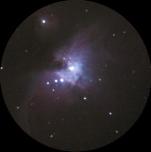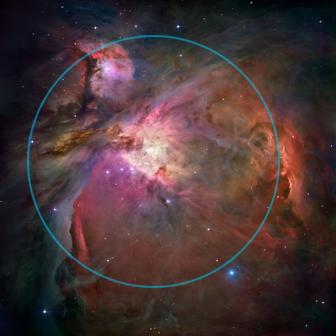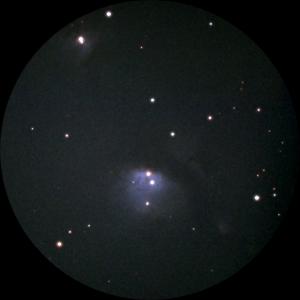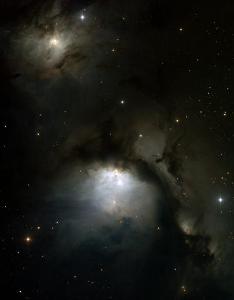
Orion & Taurus


|
Orion & Taurus |

|

There is only one other red super-giant that is this bright and it's on the opposite side of the sky, in the constellation that dominates the summer sky -- the star Antares in the constellation Scorpius. Both stars are about 500 ly away in opposite directions so we lie about halfway between the two. Such stars are rare -- there are only 200 known red super-giants and all are much dimmer, and therefore much farther away than these two stars.

The Orion Nebula (M42) in a small telescope |

...and in the Hubble Telescope |
This is the Great Orion Nebula, also known as "M42". It is one of many "M" objects named after a catalog published in the late 1700's by the Frenchman Charles Messier. Messier was a comet hunter of great renown who published a catalog of fuzzy things that might be confused with comets. These ended up being some of the most interesting objects in the sky.
This region of the sky, Orion and its neighboring constellations, happens to be one that is dense with nebulae and young stars. The only other region of the sky with this much new-star formation activity is Sagittarius and its neighboring constellations.
This nebula is remarkably clear in a telescope, binoculars, or even to the fiercely concentrated eyeball. The longer you look, the more detail you can see. Notice in the telescope how the nebula forms the shape of a ghostly bat. Look very carefully at the bright star at the center of the nebula. It's not just one star, it is actually FOUR! In fact these four stars have a special name, they are called "The Trapezium". It is their energy that lights up the nebula.
The Great Orion Nebula is huge beyond comprehension -- what you are seeing is about 1500 light years away from us. The bright region you can see is about 5 or 6 light years across, however long-exposure photographs show that this nebula covers nearly the entire constellation of Orion!
Directly above M42, much smaller and almost touching, is another nebula, M43 (logically enough). A little above the two of them, a distance that's about the size of M42, is another nebula with the colorful name "NGC 1977". NGC stands for New General Catalog -- published in 1888 it's not really that new.
| M78 in Telescope | What you're looking at |
 |
 |

This is a true "galactic cluster", meaning a group of stars all born out of the same cloud of gas. Sometimes these are called "open clusters". In photographs of the Pleiades you can still see traces of gas around the stars, remnants of the original nebula. The Pleiades lie 400 light years away from us, with a total of 500 stars in the cluster. Nine are so bright they have their own names.
Usually a star cluster looks like a tiny fuzz ball, but the Hyades appears to be a huge and distinct group of stars spread out over the sky because it's so close. Like the Pleiades, the group consists of about 400-500 stars total. Also like the Pleiades, this is a true galactic cluster, born from the same cloud of gas and all moving together in the same direction in space. They are moving away from us, toward Betelgeuse, and in 50 million years they'll be just another little fuzz ball near that star. So enjoy it now while you can. The Hyades is estimated to be about 400 million years old, making it a fairly old star group for an open cluster.
By comparison the Pleiades are much younger, at "only" 100 million years old. Galactic clusters usually are relatively young, since events conspire to break these groups up over time. The sun has long since left the nebula and cluster of its birth, travelling now through the galaxy alone, with only us to keep it company.
 Back to Winter Home Page
Back to Winter Home Page
|
 Go to Index
Go to Index
|
 On to Auriga
On to Auriga
|
Your questions and comments regarding this page are welcome.
You can e-mail Randy Culp for inquiries,
suggestions, new ideas or just to chat.
Updated 11 November 2011